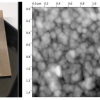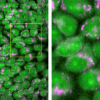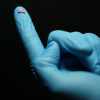Researchers at Texas A&M University have invented a new technology that can drastically reduce the size of instrumentation used for Raman spectroscopy.
“Raman benchtop setups can be up to a metre long depending on the level of spectroscopic resolution needed,” said Pao-Tai Lin, assistant professor in the Department of Electrical and Computer Engineering and the Department of Materials Science and Engineering. “We have designed a system that can potentially replace these bulky benchtops with a tiny photonic chip that can snugly fit within the tip of a finger.”
In addition, Lin said that their device is also capable of high-throughput, real-time chemical characterisation, and despite its size, is at least 10× more sensitive than conventional benchtop Raman spectroscopy systems. A description of their study is in Analytical Chemistry.
The “free-space” optical components in a conventional Raman spectrometer take up a lot of room and are a barrier for many applications where chemical sensing is required within tiny spaces or locations that are hard to reach. Also, benchtops can be prohibitive for real-time chemical characterisation. As an alternative to traditional lab-based benchtop systems, Lin and his team turned to waveguides that can transport light with very little loss of energy. While many materials can be used to make ultrathin waveguides, the researchers chose aluminium nitride, since it produces a low Raman background signal and is less likely to interfere with the Raman signal coming from the sample.
To create the optical waveguide, the researchers employed a technique used by industry for drawing circuit patterns on silicon wafers. First, using ultraviolet light, they spun a light-sensitive material, called NR9, onto a surface made of silica. Next, by using ionised gas molecules, they bombarded and coated aluminium nitride along the pattern formed by the NR9. Finally, they washed the assembly with acetone, leaving behind an aluminium waveguide that was just tens of microns in diameter.
For testing the optical waveguide as a Raman sensor, the research team transported a laser beam through the aluminium nitride waveguide and illuminated a test sample containing a mixture of organic molecules. Upon examining the scattered light, the researchers found that they could discern each type of molecule within the sample based on the Raman spectra and with a sensitivity of at least 10 times more than traditional Raman benchtops.
Lin noted since their optical waveguides are very narrow, many of them can be included on a single photonic chip. This architecture, he said, is very conducive to high-throughput, real-time chemical sensing needed for drug development.
“Our optical waveguide design provides a novel platform for monitoring the chemical composition of compounds quickly, reliably and continuously. Also, these waveguides can be easily manufactured at an industrial scale by leveraging the already existing techniques to make semiconductor devices”, Lin said. “This technology, we believe, has a direct benefit for not just pharmaceutical industries but even for other industries, like petroleum, where our sensors can be put along underground pipes to monitor the composition of hydrocarbons.”














